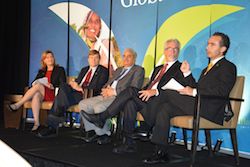The 2014 edition of the GAP Report finds that global productivity is not accelerating fast enough to meet the expected agricultural demand by 2050 through sustainable practices. Published by the Global Harvest Initiative (GHI) and released during the World Food Prize, the trend means a new global challenge is emerging: how to sustainably provide enough food, feed, fiber and fuel for a growing population by 2050 when the demands for food and agriculture will be nearly double that of today.
 The annual Gap Report takes a critical look at the state of global agriculture productivity, as well as the policies, innovations and investments needed to provide for a growing world while facing climate change. This year’s report has a special focus on the challenges and opportunities in India.
The annual Gap Report takes a critical look at the state of global agriculture productivity, as well as the policies, innovations and investments needed to provide for a growing world while facing climate change. This year’s report has a special focus on the challenges and opportunities in India.
“This year’s report shows a clear gap that could dramatically impact people all around the world,” said Dr. Margaret Ziegler, executive director of GHI who presented the key findings during a special event. “Raising productivity across all regions and for farmers of any size and scale requires long-term investment and sustained focus if we are going to have sufficient nutritious and affordable food and agriculture.”
The report is based on the measurement of total factor productivity (TFP), the ratio of agricultural outputs to inputs. Several significant productively gaps were found in key regions:
- In East Asia, only 67 percent of food demand by 2030 will be met from within the region if the current rate of productivity growth is maintained.
- At current rates of productivity growth, Sub-Saharan Africa is projected to meet only 15 percent of food demand in 2030, which will require significant imports, or food assistance, or opening up new land to development that may not be suitable for sustainable production.
- In Latin America, overall regional production is expected to exceed demand with Argentina, Brazil, Chile, Paraguay and Uruguay leading this increase in productivity.
Listen Dr. Margaret M. Zeigler discuss the key highlights of the report: 2014 GAP Report Highlights
 In addition to the release of the 2014 GAP Report, there was a panel discussion focused on the current state of the regions and ways to overcome regional challenges. The panel included: Dr. Keith Fuglie, Branch Chief of the Economic Research Service of USD; Dr. Dilip Kulkarni, President of Jain Irrigation Systems Agri-food Division; Dr. Thomas J. Herlehy, Practice Area Manager for Crops, Land O’Lakes, Inc. International Development Division; and Mr. Jesus Madrazo, Vice President, Corporate Engagement, Monsanto, and GHI Board Chairman.
In addition to the release of the 2014 GAP Report, there was a panel discussion focused on the current state of the regions and ways to overcome regional challenges. The panel included: Dr. Keith Fuglie, Branch Chief of the Economic Research Service of USD; Dr. Dilip Kulkarni, President of Jain Irrigation Systems Agri-food Division; Dr. Thomas J. Herlehy, Practice Area Manager for Crops, Land O’Lakes, Inc. International Development Division; and Mr. Jesus Madrazo, Vice President, Corporate Engagement, Monsanto, and GHI Board Chairman.
Listen to the panel discussion: 2014 GAP Report Panel Discussion

